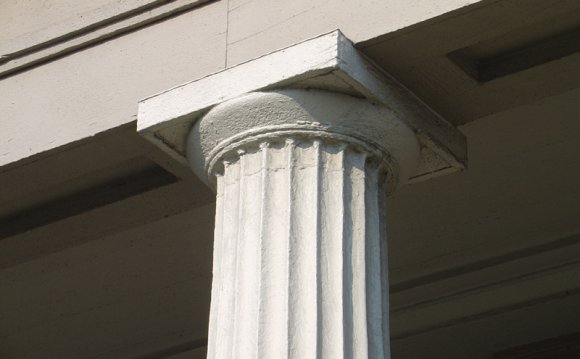
Okay, here's a test: Close your eyes and say "Greek Revival." What comes to mind? Tara from Gone With the Wind, maybe? A Deep-South vision of towering columns and broad verandahs set amidst Spanish moss and green lawns? Or how about this: A small white farmhouse in Ohio with a front-facing gable, attached pilasters at the front corners, a deep, unornamented fascia board, and a rectangular transom and sidelights at the front door? Or a tall and narrow brick town house in New York with a tiny, columned porch, a side-hall plan, and a parade of small rectangular windows just below the cornice? You couldn't go wrong with any of these optionsthey're all good examples of Greek Revival architecture in Americabut there's no question that the less ostentatious second and third versions far outnumber the Taras. From the 1820s until the Civil War, Greek Revival was a one-style-fits-all building design choice of rich and poor, in town and country, North and South, from the Atlantic Ocean to the new Midwest and around the Cape to California. There were regional variations, to be sure, and these help to make house-gazing a continuing pleasure in all these regions. Ancient Architecture Reinvented
Not that Americans were interested in re-creating an archeologically "pure" form of Greek architecture. While they admired the austere beauty of Greece's post-and-lintel buildings, their practical minds insisted on buildings that used 19th-century technology and accommodated 19th-century lifestyles. They were in search of a "National Style" of architecture reflecting their own time and placeone that would represent America's abundance and energy as well as its political and cultural ideals. They wanted a style that betokened a glorious future as well as a glorious past. The Greek example, properly modified, seemed to fit their needs. Although the details varied from region to region and from one economic stratum to another, the general characteristics of this new-old style include simplicity, as well as an emphatic rectilinear geometry and insistent symmetry of form. Vernacular Variations
The style evolved over time as well as across geographic areas, settlement patterns, and economic strata. First, in the 1820s and 1830s, came the rich man's high-style Greek Revival "temple" with its impressive four-columned two-storey portico and prominent pediment. Then, as the middle class picked up the idea in the 1830s and 1840s, the portico was scaled down. It became a porch, with plain columns or square posts and a simplified pediment. This economy version might have four columns and three bays stretching across the entire front of the house, or it might have only a single bay at the entrance. It was more often one storey high than two storeys. In freestanding houses, the temple form required a gable front, but practicality or preference very often called for end gables instead, with the entrance on a long side. Either way, the pediment might be formed by a full-length frieze or it might be merely suggested by bold cornice returns that extended only part way in from the corners. |
RELATED VIDEO












